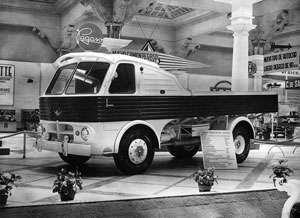Pegaso Z-207
The Pegaso Z-207 was a truck model produced in Spain by Enasa from 1955 to 1959. It featured a V6 engine and a stylishly unforgettable cab. It was nicknamed Barajas, for the location, close to Madrid, where a new Pegaso plant was built to produce the Z-207.

The Z-207 was an astonishing truck, very advanced for its time, specially due to the system of direct injection and the use of light aluminum alloy from which the whole engine block was built. Also outstanding was its high performance and perfect balance at all speeds, thanks to the balance shaft with counterrotating masses under the crankshaft. The engine had two interchangeable cylinder heads, one for each group of three cylinders, and cylinder liners of a special cast iron. It was a 7.5 l 120° V6 machine, delivering initially 110 and later 120 horsepower, enough for the vehicle to reach a top speed of 90 km/h, with its maximum weight of 11,320 kg
Another of the fundamental characteristics of the Z-207 was the independent front suspension with two superimposed trapezoids with helicoidal springs, each with a corresponding shock absorber offering a degree of comfort hitherto never attained in an industrial vehicle. A big spring joined both wheels, so guaranteeing great strength even in full load.
A further outstanding feature was the three-speed gearbox divided by the splitter-type system into three low and three high, combined with a two-speed rear axle producing a total of twelve speeds. The splitter control was mechanical, by means of a lever situated under the steering column.
The "Barajas" range also included the Z-702, an articulated truck tractor for semi-trailers suitable for a payload of ten tons, and the Z-407, a rear-engined coach that never went into mass production. There was also a four-wheel-drive prototype, coded Z-213.
Unfortunately the Z-207 was expensive to build and to maintain and was gradually replaced by the much more conventional but better-selling Pegaso Comet, which included some Leyland components. Total production of the Z-207 range was 5,737 units.
Bibliography
- Lage, Manuel. Hispano-Suiza/Pegaso. Madrid 1992. ISBN 84-7782-236-0.
External links
| Wikimedia Commons has media related to Pegaso vehicles. |
- Full "Barajas" range catalog (Spanish)